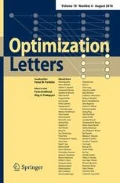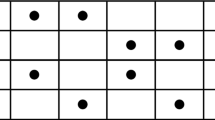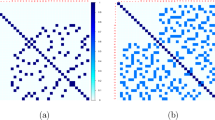Abstract
Recently pooling designs have been used in screening experiments in molecular biology. In some applications, the property to be screened is defined on subsets of items, instead of on individual items. Such a model is usually referred to as the complex model. In this paper we give an upper bound of the number of tests required in a pooling design for the complex model (with given design parameters) where experimental errors are allowed.
Similar content being viewed by others
References
Alon N., Beigel R., Kasif S., Rudich S. and Sudakov B. (2004). Learning a hidden matching. SIAM J. Comput. 33: 487–501
Beigel, R., Alon, N., Apaydin, M.S., Fortnow, L., Kasif, S.: An optimal procedure for gap closing in whole genome shotgun sequencing. In: Proceedings of 2001 RECOMB, pp. 22–30. ACM, New York (2001)
Balding, D.J., Bruno, W.J., Knill, E., Torney, D.C.: A comparative survey of nonadaptive pooling designs. In: Genetic Mapping and DNA Sequencing, IMA Volumes in Mathematics and Its Applications, pp. 133–154. Springer, Berlin (1996)
Chen H.B., Du D.Z. and Hwang F.K. (2007). An unexpected meeting of four seemingly unrelated problems: graph testing, DNA complex screening, superimposed codes and secure key distribution. J. Combin. Optim. 14: 121–129
Du D.Z. and Hwang F.K. (2000). Combinatorial Group Testing and Its Applications, 2nd edn. World Scientific, Singapore
Du D.Z. and Hwang F.K. (2006). Pooling Designs and Nonadaptive Group Testing: Important Tools for DNA Sequencing. World Scientific, Singapore
D’yachkov A.G., Vilenkin P.A., Macula A.J. and Torney D.C. (2002). Families of finite sets in which no intersection of ℓ sets is covered by the union of s others. J. Combin. Theory Ser. A 99: 195–218
Engel K. (1996). Interval packing and covering in the boolean lattice. Combin. Prob. Comput. 5: 373–384
Grebinski V. and Kucherov G. (1998). Reconstructing a Hamiltonian cycle by querying the graph: application to DNA physical mapping. Discrete Appl. Math. 88: 147–165
Kim H.K. and Lebedev V. (2004). On optimal superimposed codes. J. Combin. Designs 12: 79–91
Lovász L. (1975). On the ratio of optimal integral and fractional covers. Discrete Math. 13: 383–390
Macula A.J. and Popyack L.J. (2004). A group testing method for finding patterns in data. Discrete Appl. Math. 144: 149–157
Macula A.J., Rykov V.V. and Yekhanin S. (2004). Trivial two-stage group testing for complexes using almost disjunct matrices. Discrete Appl. Math. 137: 97–107
Macula A.J., Torney D.C. and Vilenkin P.A. (1999). Two-stage group testing for complexes in the presence of errors. DIMACS Ser. Discrete Math. Theoret. Comput. Sci. 55: 145–157
Stinson D.R. and Wei R. (2004). Generalized cover-free families. Discrete Math. 279: 463–477
Stinson D.R., Wei R. and Zhu L. (2000). Some new bounds for cover-free families. J. Combin. Theory Ser. A 90: 224–234
Torney D.C. (1999). Sets pooling designs. Ann. Combin. 3: 95–101
Wang H. and Xing C. (2001). Explicit constructions of perfect hash families from algebraic curves over finite fields. J. Combin. Theory Ser. A 93: 112–124
Author information
Authors and Affiliations
Corresponding author
Rights and permissions
About this article
Cite this article
Chen, HB., Fu, HL. & Hwang, F.K. An upper bound of the number of tests in pooling designs for the error-tolerant complex model. Optimization Letters 2, 425–431 (2008). https://doi.org/10.1007/s11590-007-0070-5
Received:
Accepted:
Published:
Issue Date:
DOI: https://doi.org/10.1007/s11590-007-0070-5




